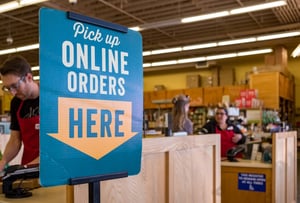Fulfillment is all about getting the right product(s) into the hands of your customers (without losing your shirt). The simplest example is an in-store ticket: The customer collects the products they want and fulfillment happens as soon as money changes hands at the register. The premise changes slightly online — the customer pays, but they won’t receive their goods for X number of days, in exchange for the convenience of shopping from home.
Omnichannel fulfillment is somewhere in between, yet is worlds more complex. While the experience for consumers is effortless when executed correctly, for retailers, it takes a concerted effort to successfully manage omnichannel fulfillment. The process requires tremendous logistics to connect digital purchases to brick-and-mortar inventories and to coordinate fulfillment in the most efficient way possible.

Here’s a look at the six biggest challenges omnichannel retailers face as they work to connect online orders to in-store fulfillment.
- Higher fulfillment expense. Shipping online orders from a single distribution center comes with a relatively predictable cost — although one is shipping individual parcels to the customer’s home. One can argue that pushing stock to each store location from a distribution center can drive margins up, through better inventory turns as well as more efficient replenishment, as opposed to centralized fulfillment. However, predicting local demand is rather challenging — and ensuring that all product will sell through is quite difficult.
- Lack of inventory visibility and metrics. To fulfill online orders in person, retailers need to utilize inventory in the right place — and push orders to a store that is close to the customer and that has inventory. This means having complete inventory visibility for every location and the metrics to show variables like inventory churn. This is especially vital for hot items and cyclical times when inventory churn is fast-paced (holidays, back-to-school, seasonal, etc.).
- More fulfillment locations. Managing dozens of local-area inventories or hundreds (if not thousands) of inventories across the country is a significant challenge. Pushing customers to the closest or best location for fulfillment adds another layer of difficulty. Retailers need a robust system for connecting online purchases to physical locations efficiently — especially when there are multiple options. Promise centrally, deliver locally and efficiently: that’s the holy grail for omnichannel.
- Fragmented supply chain. In-store sales and delivery orders both have something omnichannel fulfillment doesn’t: linear supply chain (i.e., the product goes from inventory to fulfillment). Omnichannel fulfillment isn’t so linear. When every store effectively becomes a distribution center, product moves around. Moreover, inventories are always in flux. It becomes more difficult for retailers to manage inbound and outbound inventory in this non-linear value stream.
- Split order fulfillment across stores/warehouses. Not everything is in-store or available for buy online, pickup in store (BOPIS). Retailers need to provide multi-channel fulfillment options for split orders, such as ship-to-store, ship-to-home, or secondary location pickup. Split order fulfillment across different locations adds a convoluted dynamic to an already complex fulfillment architecture. Plus, retailers would need a way to account for split orders
- Unreliable order fulfillment processes. There are dozens of variables that go into omnichannel order fulfillment beyond the items themselves. If any single variable is off, it disrupts fulfillment, creating a domino effect: from pushing back fulfillment time, to pick-and-pack mistakes, to inefficient location selection. Retailers need a system complete with checks and balances to prevent errors and frustration.

As is evident, there are a lot of extra steps and variables that make omnichannel fulfillment possible. Without a well-orchestrated system and controls in place to facilitate it, omnichannel is full of pitfalls. However, a well-designed, well-managed framework for BOPIS and ship-from-store–based fulfillment will position retailers for long-term success.
Fulfillment isn’t just about getting product into the hands of the people who order it. It’s about doing it in a way that’s logistically sound and efficient, as well as simple from a customer-facing perspective. Omnichannel fulfillment opens up a world of possibilities, but it requires complex infrastructure to capitalize on them. More importantly, it demands the ability to continuously adapt.
For optimal success, omnichannel fulfillment requires a broader scope of management than in-store or online fulfillment processes. As a result, it’s inherently more complex. This doesn’t mean, however, that retailers can’t manage the process to reduce mistakes and inefficiencies. Contact Nextuple to address your omnichannel fulfillment challenges and to leverage a modern omnichannel software as a service (SaaS) platform that can help manage these variables for your specific needs.
Learn more about the Nextuple Platform with our FREE brochure!
.png?width=250&height=56&name=nextuple_logo_vector%20(4).png)

